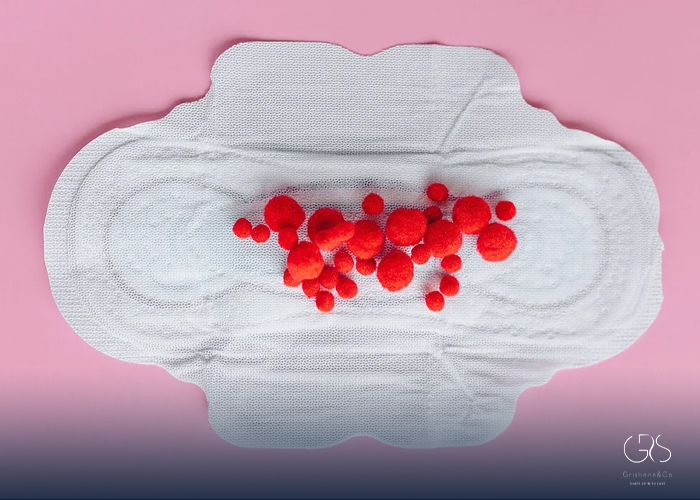The menstrual period, a natural and biological process, is experienced by most women monthly. During this time, the body sheds the uterine lining in anticipation of potential pregnancy. Some women may experience blood clots during their periods. It is crucial to understand the causes and implications of these blood clots for maintaining reproductive health.
What Do Blood Clots During a Period Look Like?
Blood clots during a period can vary in size and appearance. They are often described as thick, jelly-like substances that can range in color from dark red to bright red. Some women may notice small, pea-sized clots, while others may experience larger clots. The presence of blood clots during a period is common and is usually not a cause for concern. However, in some cases, it may signal an underlying health issue.
Causes of Blood Clots During Period
- Normal Period Variations: Blood clots during a period can be a normal variation. When menstrual blood flows slowly or is exposed to air for a longer period of time, it may clot. Additionally, hormonal changes, such as increased levels of estrogen, can cause the uterine lining to become thicker, leading to the formation of blood clots.
- Miscarriage: In some cases, the presence of blood clots during a period may indicate a miscarriage. A miscarriage occurs when a pregnancy ends before the fetus can survive outside the womb. Along with clotting, women may experience severe pain and heavier bleeding than usual.
- Uterine Abnormalities: Uterine abnormalities, such as fibroids or polyps, can contribute to the development of blood clots during a period. Fibroids are noncancerous growths that can cause heavy bleeding and clotting. Polyps are abnormal growths on the inner lining of the uterus.
- Irregular Ovulation: Irregular ovulation, where the ovaries do not release an egg regularly, can disrupt the hormonal balance in the body. This hormonal imbalance can lead to heavy and prolonged periods, which may include blood clots.
- Blood Clotting Issues: Certain medical conditions that affect blood clotting can also contribute to the formation of blood clots during a period. For instance, Von Willebrand disease, a genetic bleeding disorder, can cause heavy bleeding and clot formation. Additionally, blood-thinning medications or conditions such as anemia can affect blood clotting and contribute to clot formation.
When To See a Healthcare Provider
If you notice significant changes in your menstrual cycle, such as an increase in the amount of blood clots or if you experience severe pain, it is important to consult a healthcare provider. Additionally, seek medical attention if you experience symptoms like heavy bleeding that requires changing a pad or tampon every hour, fatigue, dizziness, or shortness of breath.
Diagnosis and Treatments for Blood Clots During Period

To determine the underlying cause of blood clots during a period, healthcare providers may conduct various diagnostic tests. These may include a pelvic examination, blood tests to check hormone levels or blood clotting factors, ultrasound, hysteroscopy, or other imaging tests.
The treatment options for blood clots during a period depend on the underlying cause. For normal variations, no specific treatment may be needed. However, if an underlying health condition is identified, treatment options such as hormonal medications, nonsteroidal anti-inflammatory drugs (NSAIDs), or surgical procedures may be recommended. In the case of blood clotting disorders, blood-thinning medications or other clotting factor replacement therapies may be prescribed.
Tips for Managing Heavy Menstrual Periods
- Keep Track of Symptoms: Keep a record of your menstrual cycles, including the pattern, duration, and severity of bleeding and clotting. This information can assist your healthcare provider in diagnosing and managing your condition.
- Maintain a Healthy Lifestyle: Adopting a healthy lifestyle can help regulate hormonal imbalances and reduce the severity of abnormal bleeding. Maintain a balanced diet, exercise regularly, and manage stress levels.
- Use Appropriate Menstrual Products: Use menstrual products that suit your needs and provide better absorption. Choose products that are specifically made for heavy flows and consider using a pad or tampon with a higher absorbency level.
- Apply Heat: Applying heat to the lower abdomen can help alleviate cramps and promote blood flow, potentially reducing blood clot formation.
- Discuss Alternative Treatment Options: If menstrual bleeding and clotting become unmanageable, discuss alternative treatment options with your healthcare provider. These may include hormonal contraceptives, intrauterine devices (IUDs), or other interventions.
Conclusion:
Understanding the causes and implications of blood clots during a period is crucial for maintaining reproductive health. While blood clots are often a normal part of the menstrual cycle, changes in size, frequency, or associated symptoms should be discussed with a healthcare provider. Early diagnosis and appropriate treatment can help alleviate symptoms and address any underlying health issues, ensuring overall well-being and menstrual health.
Sources
- Blood clots during your period, Heavy periods
- The American College of Obstetricians and Gynecologists, Heavy Menstrual Bleeding
- Mayo Clinic, Miscarriage
- Healthline, Uterine Fibroids
- MedlinePlus, Blood Clots
- Medical News Today, How to stop or speed up your period




